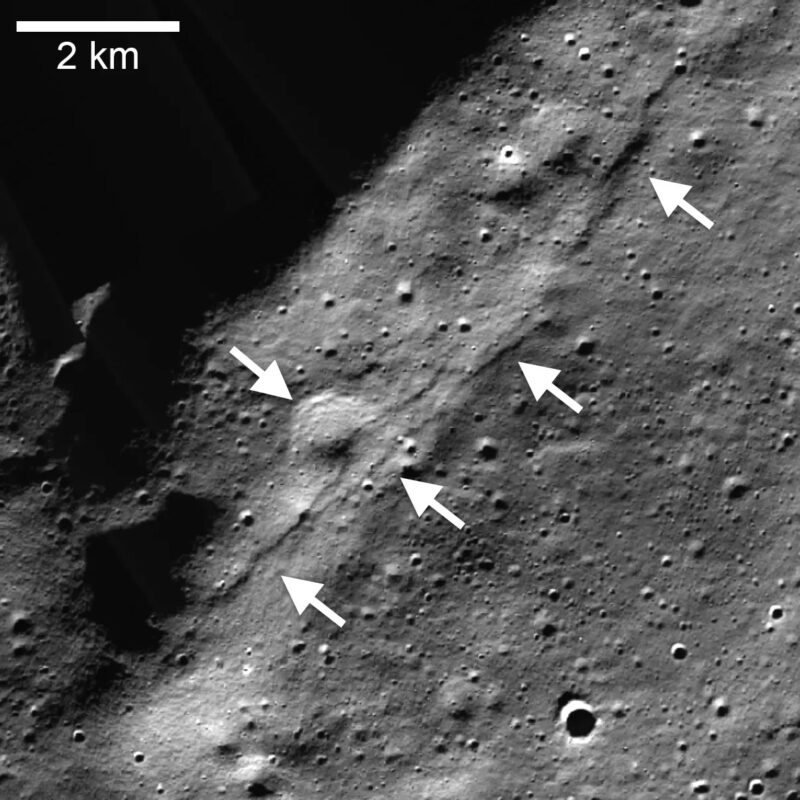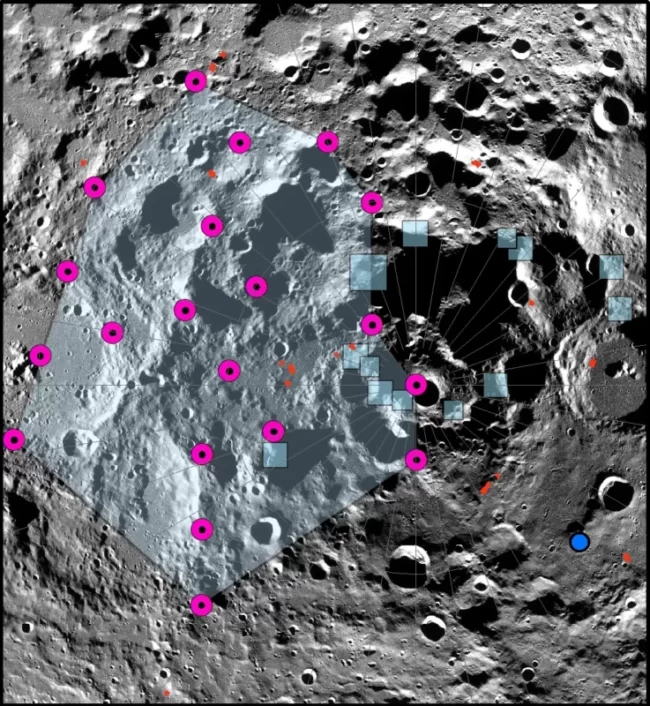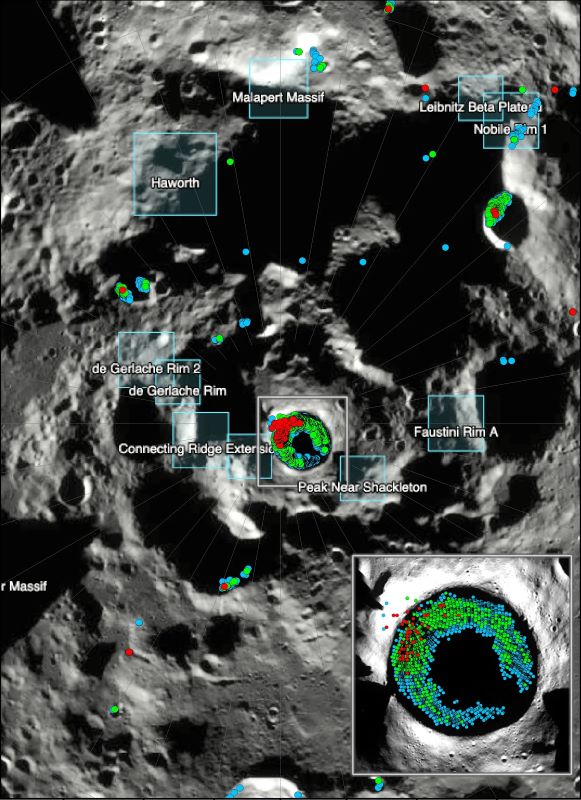
NASA published this original story on January 25, 2024. Edits by EarthSky.
The moon is shrinking and causing moonquakes
In the next few years, NASA plans to send astronauts to the lunar south pole region with its Artemis campaign. On January 25, 2024, NASA released data from a study that helps scientists better understand this strategic part of the moon. The study says moonquakes and faults generated as the moon’s interior gradually cools and shrinks include areas near and within some of the identified candidate landing regions for Artemis 3’s first crewed landing.
Tom Watters of the Smithsonian Institution in Washington, D.C., was lead author of a paper on the research published January 25 in the peer-reviewed Planetary Science Journal. He said:
Our modeling suggests that shallow moonquakes capable of producing strong ground shaking in the south polar region are possible from slip events on existing faults or the formation of new thrust faults. The global distribution of young thrust faults, their potential to be active, and the potential to form new thrust faults from ongoing global contraction should be considered when planning the location and stability of permanent outposts on the moon.
Tracking moon quakes
The Lunar Reconnaissance Orbiter Camera onboard NASA’s Lunar Reconnaissance Orbiter (LRO) has detected thousands of relatively small, young thrust faults widely distributed in the lunar crust. The scarps are cliff-like landforms that resemble small stair-steps on the lunar surface. They form where contractional forces break the crust and push or thrust it on one side of the fault up and over the other side. The contractions and global shrinking are due to tidal forces from Earth and the cooling of the moon’s still-hot interior.
The formation of the faults includes seismic activity in the form of shallow-depth moonquakes. The Apollo Passive Seismic Network recorded shallow moonquakes with a series of seismometers that Apollo astronauts deployed. The strongest recorded shallow moonquake had an epicenter in the south polar region. One young thrust-fault scarp, located within the de Gerlache Rim 2, is an Artemis 3 candidate landing region. The study modeled it to show the formation of this fault scarp could have been associated with a moonquake of the recorded magnitude.

Lunar south pole: Home of ice and quakes
The team also modeled the stability of surface slopes in the lunar south polar region and found that some areas are susceptible to regolith landslides from even light seismic shaking. That includes areas in some permanently shadowed regions where there might be ice.
Renee Weber, a co-author of the paper at NASA’s Marshall Space Flight Center, Huntsville, Alabama, said:
To better understand the seismic hazard posed to future human activities on the moon, we need new seismic data, not just at the south pole, but globally. Missions like the upcoming Farside Seismic Suite will expand upon measurements made during Apollo and add to our knowledge of global seismicity.

Bottom line: The moon is shrinking and causing moonquakes and faults near its south pole. This region is important for future Artemis missions because it has deposits of ice.
Source: Tectonics and Seismicity of the Lunar South Polar Region
The post The moon is shrinking, causing moonquakes near planned Artemis landing sites first appeared on EarthSky.
from EarthSky https://ift.tt/MCuPdRF

NASA published this original story on January 25, 2024. Edits by EarthSky.
The moon is shrinking and causing moonquakes
In the next few years, NASA plans to send astronauts to the lunar south pole region with its Artemis campaign. On January 25, 2024, NASA released data from a study that helps scientists better understand this strategic part of the moon. The study says moonquakes and faults generated as the moon’s interior gradually cools and shrinks include areas near and within some of the identified candidate landing regions for Artemis 3’s first crewed landing.
Tom Watters of the Smithsonian Institution in Washington, D.C., was lead author of a paper on the research published January 25 in the peer-reviewed Planetary Science Journal. He said:
Our modeling suggests that shallow moonquakes capable of producing strong ground shaking in the south polar region are possible from slip events on existing faults or the formation of new thrust faults. The global distribution of young thrust faults, their potential to be active, and the potential to form new thrust faults from ongoing global contraction should be considered when planning the location and stability of permanent outposts on the moon.
Tracking moon quakes
The Lunar Reconnaissance Orbiter Camera onboard NASA’s Lunar Reconnaissance Orbiter (LRO) has detected thousands of relatively small, young thrust faults widely distributed in the lunar crust. The scarps are cliff-like landforms that resemble small stair-steps on the lunar surface. They form where contractional forces break the crust and push or thrust it on one side of the fault up and over the other side. The contractions and global shrinking are due to tidal forces from Earth and the cooling of the moon’s still-hot interior.
The formation of the faults includes seismic activity in the form of shallow-depth moonquakes. The Apollo Passive Seismic Network recorded shallow moonquakes with a series of seismometers that Apollo astronauts deployed. The strongest recorded shallow moonquake had an epicenter in the south polar region. One young thrust-fault scarp, located within the de Gerlache Rim 2, is an Artemis 3 candidate landing region. The study modeled it to show the formation of this fault scarp could have been associated with a moonquake of the recorded magnitude.

Lunar south pole: Home of ice and quakes
The team also modeled the stability of surface slopes in the lunar south polar region and found that some areas are susceptible to regolith landslides from even light seismic shaking. That includes areas in some permanently shadowed regions where there might be ice.
Renee Weber, a co-author of the paper at NASA’s Marshall Space Flight Center, Huntsville, Alabama, said:
To better understand the seismic hazard posed to future human activities on the moon, we need new seismic data, not just at the south pole, but globally. Missions like the upcoming Farside Seismic Suite will expand upon measurements made during Apollo and add to our knowledge of global seismicity.

Bottom line: The moon is shrinking and causing moonquakes and faults near its south pole. This region is important for future Artemis missions because it has deposits of ice.
Source: Tectonics and Seismicity of the Lunar South Polar Region
The post The moon is shrinking, causing moonquakes near planned Artemis landing sites first appeared on EarthSky.
from EarthSky https://ift.tt/MCuPdRF

Aucun commentaire:
Enregistrer un commentaire